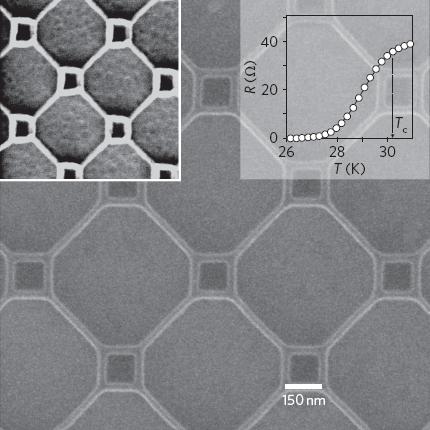Researchers from Germany in an international collaboration have discovered a magnetic "signature" that appears in all iron-based superconducting materials, even if the original compounds from which the superconductors are obtained have different chemical properties.

Since the discovery of a new family of superconductors in 2008, there has been a flood of research into it around the world. Unlike the family that was known before - copper-based ceramic materials (cuprates), the basic structure of this new family of materials consists of iron compounds. Since these materials differ from the known family in many essential ways, there is hope for generating new insights into the origins of the appearance of superconductivity.
In collaboration with an international research group, researchers from the German university Helmholtz-Zentrum Berlin (HZB) have now discovered a magnetic "signature" that appears in all iron-based superconducting materials, even if the original compounds from which the superconductors are obtained have different chemical properties. The research findings were published in the scientific journal Nature Materials.
Superconductors are generally obtained by doping the parent compounds, i.e. introducing foreign atoms into the original materials. There is a close correlation between magnetism and superconductivity - both properties of solid materials. Common superconductors, such as those used in MRI machines found in hospitals, do not accept magnetism willingly because it interferes with the interactions that lead to superconductivity within the crystal. This is fundamentally different for the superconductors that operate at high temperature, such as cuprates and iron-arsenic compounds. In these materials, the magnetic forces actually help and even promote the activation of superconductivity. In these compounds there are ordered patterns of magnetism whose presence in crystalline structures is a suggestive sign that the material is suitable to be used as a superconductor at high temperature. It turns out that with the new iron-based conductors, the symmetry of the magnetic patterns exactly matches the symmetry of the superconducting signal.
The German researchers prepared crystals of iron-tellurium-selenium (iron-tellurium-selenium) and determined their chemical composition using X-ray measurement methods and neutron diffraction. This is how they measured the magnetic signals inside the crystals. They discovered that the symmetry of the magnetic pattern is fundamentally different from that found in the iron-based parent compounds, such as iron-arsenic compounds. Nevertheless, surprisingly, this difference does not affect the acceptance of superconductivity as a characteristic. The researchers noticed that the magnetic signal received by the superconducting material - sometimes referred to as "magnetic resonance" - has the same symmetry as the magnetic pattern. And this symmetry is the same in all iron compounds, and is probably created following a general mechanism responsible for the ability of superconductivity in all these materials.
Lead researcher Dimitri Argyriou describes this feature: “Given what we know about the magnetic pattern for iron compounds, the iron-tellurium-selenium-based materials should not have been superconductors. But in this case the exact opposite happens: despite the differences in magnetism, the signature of the superconductivity property is the same in all of them. If as a result of these findings we can understand how superconductivity is created despite different opening conditions, then we may be able to develop materials that will be superconducting even at higher temperatures."

4 תגובות
Hello fan.
Thanks for the compliment.
I also enrich my scientific knowledge this way.
Read on and get educated….
Hello moshe,
Thanks.
I would like to take this opportunity to thank you for the interesting articles you bother to bring!
Hello fan.
Indeed you were right - a generalization was made out of place. However, it must be understood that this generalization originates from the original news published in English, and that the information here is basically popular science and not academic and detailed.
It is advisable not to make generalizations about superconductors such as: "Superconductors are generally obtained through "doping" (intentional contamination, "doping") of the parent compounds, that is, the introduction of foreign atoms into the original materials. There is a close correlation between magnetism and superconductivity."
Superconductors are divided into several fundamentally different types. Standard superconductivity was discovered about a century ago and explained by a physical model known as BCS after its discoverers (who won the Nobel Prize for it) Bardin, Cooper and Schreiper. As far as I know, superconductors of this type do not need conduction to exist. relative to the magnetic field
These superconductors are divided into two types called (surprisingly) TypeI and TypeII where TypeII allows a magnetic field to penetrate the superconductor. The rejection of the magnetic field inside the superconductor is known as the Meissner effect, while the penetration of the magnetic field into the superconductor with type II conductors is via vortex lines.
About twenty-five years ago, superconductors of a different type were discovered. High-temperature superconductors Copper-based ceramic materials In these materials, superconductivity is closely related to the level of conductivity and which materials are antiferromagnetic at room temperature. Such superconductors do not yet have a physical mechanism that explains how they become superconductors and this is one of the open problems in the field of solid state. In addition to all this, the above article deals with another type of conductor based on iron compounds.